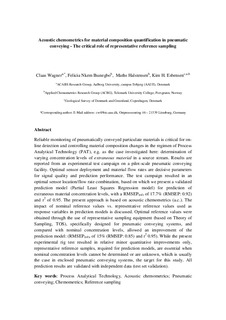Acoustic chemometrics for material composition quantification in pneumatic conveying - The critical role of representative reference sampling
Journal article, Peer reviewed
Accepted version

Åpne
Permanent lenke
http://hdl.handle.net/11250/2438426Utgivelsesdato
2012Metadata
Vis full innførselSamlinger
Originalversjon
Wagner, C., Ihunegbo, F.N., Halstensen, M. & Esbensen, K.H. Acoustic chemometrics for material composition quantification in pneumatic conveying - The critical role of representative reference sampling. Powder Technology. 2013, 237, p. 506-513 http://dx.doi.org/10.1016/j.powtec.2012.12.036Sammendrag
Reliable monitoring of pneumatically conveyed particulate materials is critical for online detection and controlling material composition changes in the regimen of Process Analytical Technology (PAT), e.g. as the case investigated here: determination of varying concentration levels of extraneous material in a source stream. Results are reported from an experimental test campaign on a pilot-scale pneumatic conveying facility. Optimal sensor deployment and material flow rates are decisive parameters for signal quality and prediction performance. The test campaign resulted in an optimal sensor location/flow rate combination, based on which we present a validated prediction model (Partial Least Squares Regression model) for prediction of extraneous material concentration levels, with a RMSEP(rel) of 17.7% (RMSEP: 0.92) and r2 of 0.95. The present approach is based on acoustic chemometrics (a.c.). The impact of nominal reference values vs. representative reference values used as response variables in prediction models is discussed. Optimal reference values were obtained through the use of representative sampling equipment (based on Theory of Sampling, TOS), specifically designed for pneumatic conveying systems, and compared with nominal concentration levels, allowed an improvement of the prediction model: (RMSEP(rel), of 15% (RMSEP: 0.85) and r2 0.95). While the present experimental rig test resulted in relative minor quantitative improvements only, representative reference samples, required for prediction models, are essential when nominal concentration levels cannot be determined or are unknown, which is usually the case in enclosed pneumatic conveying systems, the target for this study. All prediction results are validated with independent data (test set validation)